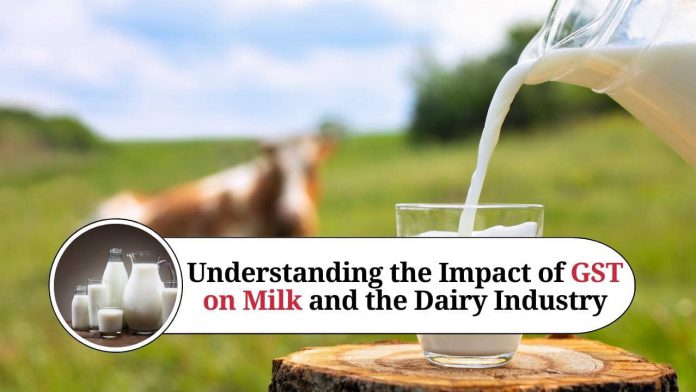Goods and Services Tax (GST) on Milk: An Overview
Milk is an essential commodity consumed by millions of people every day. With the implementation of the Goods and Services Tax (GST) in India, the price of milk and other dairy products has become a topic of interest for many consumers. In this blog, we will take a closer look at the GST on milk and its impact on consumers.
GST on Milk
Under the GST regime, milk is taxed at a rate of 5%. This tax applies to both packaged and unpackaged milk. However, there are some exceptions. For example, skimmed milk powder, which is used as an ingredient in various food items, is taxed at a rate of 12%.
Impact of GST on Milk Prices
The GST on milk has had a mixed impact on the prices of this essential commodity. On one hand, the 5% GST rate is relatively low and has not resulted in a significant increase in the price of milk. On the other hand, the increase in the price of skimmed milk powder, due to the 12% GST rate, has been passed on to consumers in the form of higher prices for dairy products such as cheese, paneer, and ice cream.
Moreover, the GST regime has also resulted in an increase in the cost of production for dairy farmers. This is because they are now required to pay GST on inputs such as feed, fodder, and veterinary services. This increase in the cost of production has also been passed on to consumers in the form of higher prices for milk and other dairy products.
Benefits of GST on Milk
Despite the mixed impact of GST on the prices of milk and other dairy products, there are several benefits of the GST regime for the dairy industry. For example, the GST has led to the formalization of the dairy sector, which was previously dominated by unorganized players. This has resulted in increased transparency, better pricing, and improved quality of dairy products for consumers.
Read Other Useful Blogs:
In addition, the GST has also made it easier for dairy farmers and processors to do business by simplifying the tax system. This has led to increased efficiency, reduced costs, and increased competitiveness for the dairy industry.
Conclusion
In conclusion, the GST on milk has had a mixed impact on the prices of this essential commodity. While the 5% GST rate has not resulted in a significant increase in the price of milk, the increase in the price of skimmed milk powder has been passed on to consumers in the form of higher prices for dairy products. However, the GST has also brought several benefits to the dairy industry, such as formalization, improved efficiency, and increased competitiveness.
Overall, the GST regime has led to some challenges for the dairy industry and consumers, but it has also brought about several benefits. The formalization of the dairy sector and the simplification of the tax system have been particularly positive for the industry and for consumers, who can now access better quality dairy products.
In recent years, the dairy industry in India has grown significantly and is now a major contributor to the country’s economy. The industry provides livelihoods for millions of people, including farmers, processors, and dairy workers. The GST has played a role in this growth by providing a more stable and predictable tax environment for the industry.
However, it is important to note that the dairy industry still faces several challenges, such as low milk prices, a lack of access to credit, and poor infrastructure. The government and industry players need to work together to address these challenges and support the growth of the dairy industry.
Frequently Asked Questions (FAQ’s)
Q.1) What is the GST rate on milk?
The GST rate on milk is 5%.
Q.2) Is GST applicable to both packaged and unpackaged milk?
Yes, GST is applicable to both packaged and unpackaged milk.
Q.3) What is the GST rate on skimmed milk powder?
The GST rate on skimmed milk powder is 12%.
Q.4) Has the GST affected the prices of milk and dairy products?
The GST has had a mixed impact on the prices of milk and dairy products. While the 5% GST rate has not resulted in a significant increase in the price of milk, the increase in the price of skimmed milk powder has been passed on to consumers in the form of higher prices for dairy products.
Q.5) How has the GST impacted the cost of production for dairy farmers?
The GST has increased the cost of production for dairy farmers as they are now required to pay GST on inputs such as feed, fodder, and veterinary services.
Q.6) What are the benefits of GST for the dairy industry?
The GST has led to the formalization of the dairy sector, improved efficiency, and increased competitiveness for the industry. It has also simplified the tax system and made it easier for dairy farmers and processors to do business.
Q.7) What challenges does the dairy industry still face?
The dairy industry still faces challenges such as low milk prices, a lack of access to credit, and poor infrastructure.
Q.8) How can the government and industry players support the growth of the dairy industry?
The government and industry players need to work together to address the challenges faced by the dairy industry and support its growth. This may involve addressing issues such as low milk prices, improving access to credit, and investing in better infrastructure.
Q.9) Is the GST seen as a positive step for the dairy industry in India?
Overall, the GST is seen as a positive step towards the growth and development of the dairy industry in India. Despite the challenges, the GST has brought several benefits, such as formalization, improved efficiency, and increased competitiveness.




















